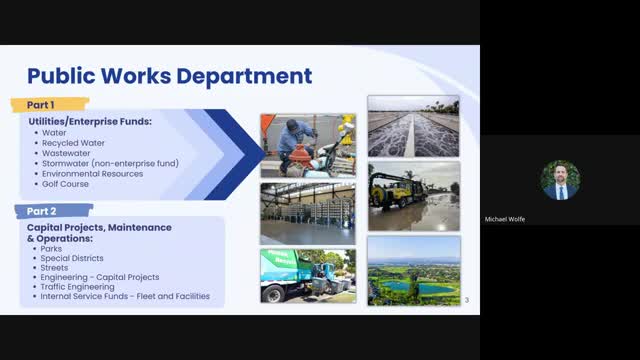Oxnard City highlights water supply sources, warns of groundwater adjudication risk
October 23, 2025 | Oxnard City, Ventura County, California
This article was created by AI summarizing key points discussed. AI makes mistakes, so for full details and context, please refer to the video of the full meeting. Please report any errors so we can fix them. Report an error »

Michael Wolf, public works director for Oxnard City, told a public works workshop ahead of the Nov. 3 City Council meeting that the city’s potable water supply comes from the State Water Project, Oxnard’s groundwater wells and regional groundwater sources, and that city leaders are prioritizing reliability, diversification and cost control.
Wolf said Oxnard City “has over 540 employees, a $270,000,000 operating budget, and a $700,000,000 five‑year capital improvement program.” He said roughly 30%–40% of potable supply is delivered through the State Water Project via Metropolitan and a member agency, with the remainder pumped from local and regional groundwater wells or produced from the city’s recycled water facilities.
The presentation identified key infrastructure: a groundwater desalter, an advanced water purification facility (AWPF) for recycled water, six blending stations, wells that supply groundwater and about 550 miles of underground pipelines. Wolf said the system treats and produces about 23,000,000 gallons of potable water per day and that the water division processes roughly 57,000 service requests per year, from turn‑ons to leak responses.
Why it matters: city water supply and project pacing affect customer rates, capital planning and long‑term availability. City staff said they are pacing capital projects below full execution to limit rate impacts while balancing deferred maintenance.
Among accomplishments Wolf cited were expanded recycled water pumping — he said the city pumped about 500 acre‑feet of recycled water allocation last water year in coordination with the Fox Canyon Groundwater Management Agency — and progress on an aquifer storage and recovery (ASR) demonstration well now in construction. The ASR project is intended to allow the city to store recycled water underground for later use.
The presentation listed several risks. Wolf said the ongoing groundwater adjudication process could increase costs and “potentially … have less water rights to pump,” which would affect supply and cost. He also cited weather variability, funding and cost increases, unfunded regulatory mandates and the need to meet emerging water quality rules such as limits for PFAS/PFOS chemicals.
On capital planning and rates, Wolf said staff recommended a slower CIP execution pace — approximately 25%–35% in some fiscal years — to keep rates lower, while cautioning that deferring projects raises deferred‑maintenance risk and could reduce reliability.
Wolf recommended keeping the council priority of ensuring adequate future water supply and continuing work on ASR permitting, groundwater access and capital maintenance to protect supplies and affordability.
Ending: Staff said they will present the utilities and enterprise sections at the Nov. 3 council meeting and will return later in November to cover capital projects, maintenance and operations.
Wolf said Oxnard City “has over 540 employees, a $270,000,000 operating budget, and a $700,000,000 five‑year capital improvement program.” He said roughly 30%–40% of potable supply is delivered through the State Water Project via Metropolitan and a member agency, with the remainder pumped from local and regional groundwater wells or produced from the city’s recycled water facilities.
The presentation identified key infrastructure: a groundwater desalter, an advanced water purification facility (AWPF) for recycled water, six blending stations, wells that supply groundwater and about 550 miles of underground pipelines. Wolf said the system treats and produces about 23,000,000 gallons of potable water per day and that the water division processes roughly 57,000 service requests per year, from turn‑ons to leak responses.
Why it matters: city water supply and project pacing affect customer rates, capital planning and long‑term availability. City staff said they are pacing capital projects below full execution to limit rate impacts while balancing deferred maintenance.
Among accomplishments Wolf cited were expanded recycled water pumping — he said the city pumped about 500 acre‑feet of recycled water allocation last water year in coordination with the Fox Canyon Groundwater Management Agency — and progress on an aquifer storage and recovery (ASR) demonstration well now in construction. The ASR project is intended to allow the city to store recycled water underground for later use.
The presentation listed several risks. Wolf said the ongoing groundwater adjudication process could increase costs and “potentially … have less water rights to pump,” which would affect supply and cost. He also cited weather variability, funding and cost increases, unfunded regulatory mandates and the need to meet emerging water quality rules such as limits for PFAS/PFOS chemicals.
On capital planning and rates, Wolf said staff recommended a slower CIP execution pace — approximately 25%–35% in some fiscal years — to keep rates lower, while cautioning that deferring projects raises deferred‑maintenance risk and could reduce reliability.
Wolf recommended keeping the council priority of ensuring adequate future water supply and continuing work on ASR permitting, groundwater access and capital maintenance to protect supplies and affordability.
Ending: Staff said they will present the utilities and enterprise sections at the Nov. 3 council meeting and will return later in November to cover capital projects, maintenance and operations.
View full meeting
This article is based on a recent meeting—watch the full video and explore the complete transcript for deeper insights into the discussion.
View full meeting
